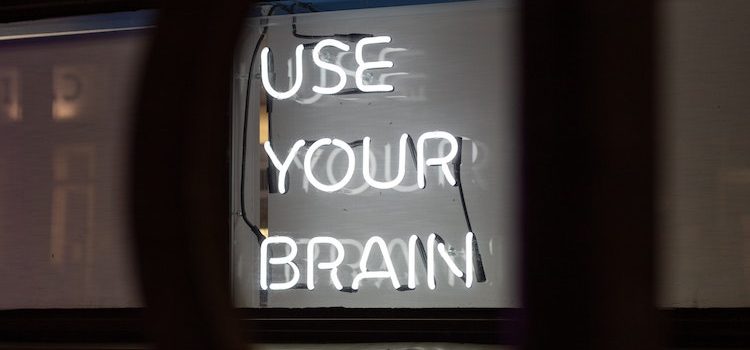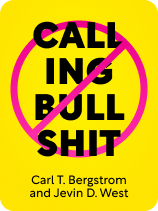
Do you tend to believe everything you hear? Would you like to foster healthy skepticism without falling into the trap of cynicism?
Let’s be frank: The modern world is replete with bullshit—a phenomenon that professors Carl T. Bergstrom and Jevin D. West define as the use of misleading evidence to persuade an audience. But, we aren’t defenseless against this bullshit, they argue.
Read more to learn how to be skeptical and identify bullshit in its many forms.
How to Be Skeptical
Bergstrom and West’s advice for how to be skeptical contains three key strategies for identifying bullshit: Evaluate information sources, scrutinize claims that are “too good to be true,” and be wary of confirmation bias.
Strategy #1: Evaluate Information Sources
Bergstrom and West explain that we should assess information sources by asking who the information is coming from and what their possible motivations are. After all, many information sources have ulterior motives, meaning they’re more likely to use bullshit to support their aims. For example, in light of conclusive evidence linking smoking to lung cancer in the 1950s, the tobacco industry conducted a marketing campaign that sought to undermine this scientific consensus (and thus retain their massive profits). This campaign was rife with bullshit, but by asking what the tobacco industry’s underlying motivations were, you could have easily detected this bullshit.
(Shortform note: One important step in evaluating information sources is to scan for bias—that is, a predisposition toward a certain viewpoint that can conflict with neutral reporting. Experts note that there are many indicators of a biased information source. For instance, biased sources typically use extreme language with sweeping generalizations, rather than more circumspect, qualified language. Moreover, biased sources are often emotionally charged rather than dispassionate reporters of facts.)
Strategy #2: Scrutinize Implausible Claims
Next, Bergstrom and West recommend being careful when you encounter claims that seem too good to be true. In other words, if a claim seems absolutely implausible, there is a good chance that it’s bullshit. For instance, in so-called “Nigerian prince scams,” scammers email potential targets claiming to be international royalty in need of financial assistance, promising to quickly return your loans with sizable interest. These scams are too good to be true—Nigerian royalty certainly wouldn’t solicit loans via anonymous emails. Thus, by treating such claims with a healthy amount of skepticism, you’ll often be able to detect bullshit.
(Shortform note: Bergstrom and West’s recommended dose of skepticism jibes well with astronomer Carl Sagan’s aphorism that “extraordinary claims require extraordinary evidence”—that is, to believe an incredible claim, you should have similarly incredible evidence. In philosophy, this notion follows from evidentialism, the view that we should proportion our beliefs to our relevant evidence. By applying this insight from evidentialism, you’ll be less likely to believe outlandish claims without sufficient evidence in their favor.)
Strategy #3: Remain Cognizant of Confirmation Bias
Finally, Bergstrom and West caution us that confirmation bias—the tendency to hold claims that conform to our preexisting views to lower evidentiary standards—can blind us to bullshit. For example, imagine that allegations broke that a politician you disliked had committed fraud or had an affair. If you already distrusted that politician, you might be more likely to accept these allegations at face value—even if they ultimately proved to be bullshit.
(Shortform note: Experts offer several concrete strategies for mitigating the effects of confirmation bias. For instance, because confirmation bias is most prevalent when you’re only exposed to information sources that reflect your views, you should diversify your information sources to create a more objective foundation of facts. Additionally, the experts suggest seeking out discussions with those who disagree with you, since such individuals can make you more cognizant of your own biases and expose you to new information and ideas.)
Exercise: Practice Identifying and Calling Bullshit
Bergstrom and West provide an array of strategies for identifying bullshit. In this exercise, practice implementing these strategies to practice skepticism and recognize bullshit online and in the news.
- Think about some recent news stories you’ve encountered that seem likely to contain bullshit. Describe some of the specific claims you think might be bullshit.
- Using Bergstrom and West’s three strategies (evaluate information sources, scrutinize implausible claims, remain wary of confirmation bias), assess one of these claims. In light of these strategies, do you still think the claim is bullshit? Why?

———End of Preview———
Like what you just read? Read the rest of the world's best book summary and analysis of Carl T. Bergstrom and Jevin D. West's "Calling Bullshit" at Shortform.
Here's what you'll find in our full Calling Bullshit summary:
- That misinformation online, in news, and in academia is spreading
- How to detect and refute bullshit in its many forms
- How data can be miscollected and misinterpreted in science






